-
Posts
1,742 -
Joined
-
Last visited
-
Days Won
3
Content Type
Profiles
Forums
Blogs
Gallery
Events
Store
Posts posted by Greg Collins
-
-
Hey Doc,
Old eyes being what they are- are the darker stripes on the ribbons of those orders red or maroon? If red, that award was given for hostile action while the maroon indicates more meritorious service. The red is quite rare (and more expensive). In my opinion, you'd be better off using the same award but with the maroon and yellow ribbon... much more commonly given.
0 -
Also, as this is the "Gala" uniform, you may not want to show all the awards an individual was entitled to- especially if you choose to go with medals instead of ribbon bars. What I'm getting at is this; this particular uniform was for evening wear or to a special event- perhaps a concert or luncheon- where too much "lettuce" would appear a bit gauch. As the DDR, like most countries, did not have miniature awards, the wearer would often restrict the number of awards worn to the highest achievements. I have seen this uniform, worn by a Lt. Colonel, with only one award- a silver Kampforden. Something to think about.
0 -
I concur with Gordon that the medals currently on the uniform- all for Socialistic Work- are out of place. Here's what I'd expect to see (starting with the highest award):
-A Kampforden, possibly silver
-A Waffenbruderschaft, also silver
-Meritorious Mariner (a Merchant Fleet award)
-A Hufeland Medal (gold or silver)
-30th Ann. of the DDR
-30th Ann. of the NVA
-15 Years NVA Service
-10 Years NVA Service
-5 Years NVA Service
Possible foreign awards:
- Soviet Combat Cooperation (maybe- more often awarded to Admirals)
- Bulgarian Brotherhood in Arms (probably)
In my opinion, this would make a nice, convincing ribbon bar on this uniform (but you know what they say about opinions).
0 -
Now to the two small badges... the badge on the left is RPR and the badge on the right is RSR but I have no idea what their application would have been.
Question #4- does anyone have any idea to what organization these badges belong?
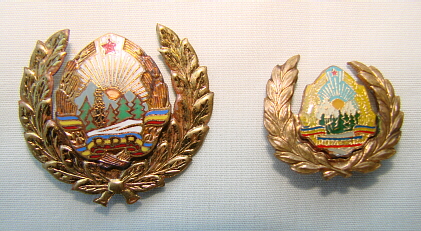 0
0 -
Now (and in the upper left), the RPR star cap badge for NCO's through Colonels. In the upper right, a transitional RSR officers' cap badge. The two badges below are there simply to show their relative size. These two will be seen in detail in the next post.
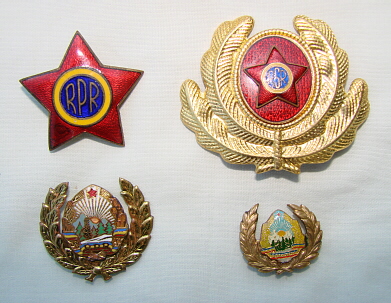 0
0 -
Next, a collection of Militia cap badges. In the upper left, a cap badge for Sergeants, Warrent Officers and Cadets until 1979- after that, only cadets would continue to wear this badge; in the upper right, cap badge for the Patriotic Guard. In the lower left is a post 1979 Sergeants' and Warrent Officers' cap badge and, in the lower right, an officers' (Lt. through Col.) cap badge.
Question #2- would the overseas cap badge be the same?
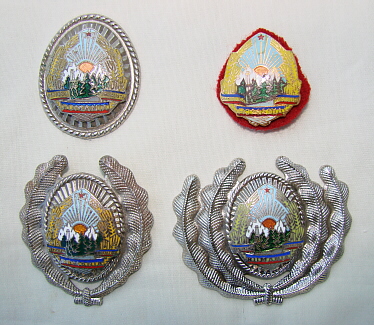 0
0 -
I have amassed several cap badges from both the RPR and RSR periods that I'd like to show and, as always, have some questions about.
First, a collection of RSR military badges: The large badge at the top is an Air Force badge for officers (Lieutenants through Colonels), the badge on the lower left is an Army officers' badge, in the center is a Colonels' collar insignia, and on the lower right is an Army post 1979 Sergeants' and Warrent Officers' cap badge.
Security Troops have would have worn the same cap insignia as the Army.
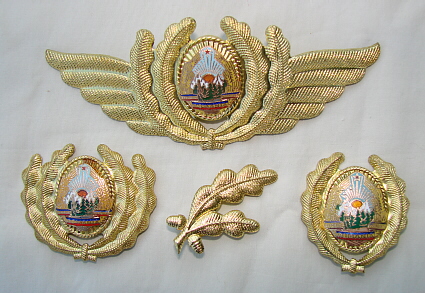 0
0 -
Thanks, Kevin! I'm looking at their cap emblem and what I'm seeing is a metal Romanian seal (no oval backing) on possily a material backing. Is that correct? Also, I believe their piping colour was a more or less royal blue... what colour are the uniforms? Are the uniforms basically the same as the uniforms for the army but with their distintive insignia and piping colour?
0 -
Through research and the help I've received here, I'm fairly up on the RSR Militia uniform- thanks to all. Now, does anyone have a link, image or example of uniforms of the Security Troops?
0 -
I know that I'm "going against the grain" on this one but, setting aside the fact that the RPR's are definitely more valuable, I just like the RSR's more. The larger, rounder "inner wings", the fact that the headphones have become almost unrecognizable and the use of fluorescent yellow (in a military badge) just does it for me... kind of a "Galaxy Quest" (one of my favorite movies- if that tells you something) kinda thing. If I ever latch on to one of these, I'm wearing it at the next convention!
0 -
Absolutely right, it is "Tacaks" and I've edited the post to show this correction. Also, thanks for the name of the Secretary.
A friend has gone into Bucharest this week so, hopefully, he'll be able to find a medal to go with the document.
0 -
Close-ups of the "signatures"...
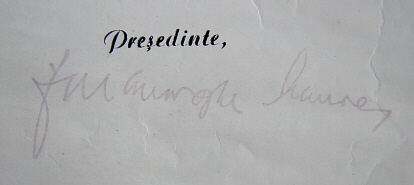
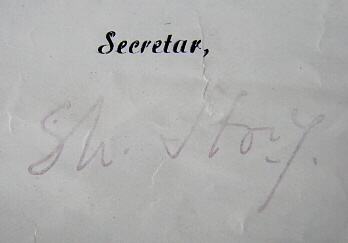 0
0 -
Recently came by the RSR document for the Order for Distinguished Services in Defense of the Social Order and the Country - 3rd Class (Ordinul "Pentru servicii deosebite aduse ?n ap?rarea or?nduirii sociale ?i de stat"). It was awarded August 18, 1959 by Ion Georghe Maurer (President 1958-1961) to Comrade Major Ioan Tacaks. Unfortunately, the medal (red star with large RSR seal; 5 side suspension; blue ribbon with three narrow red stripes at both sides) was not included so I'm still looking for one. Am happy to have the document as I've never seen one before. The paper is "pinkish" in colour. The signatures appear to be stamped. I can't identify the Secretary's name and would appreciate it if someone could tell me. Thanks!
 0
0 -
I realize no time period was mentioned to this point- that was, more or less, just me thinking. Seems the shoulderboards you showed, which I agree are the same as the shoulderboards featured on the uniform image I showed, seem to relate to the third pair of boards in post #37 as far as type and time. They are RSR. So, taking all that into account, I believe I'm safe in saying that the uniform is a Militia uniform from the RSR period.
Also have been thinking of the ribbon bar... the highest ribbon that would indicate service time is the Order of Military Merit 1st Class (25 years). The Order for the Defense of the Social Order and Country 3rd Class and the Protector of the Fatherland could both be awarded to Sergeants and up. Could it be possible that we're looking at the ribbon bar of a career top Sergeant? I know that in the US forces it is not uncommon to see a Sergeant Major or Master Chief's ribbons looking considerably more impressive than, say, a Colonel or Navy Captain's. Would this have also been true in the Romanian services of that time?
0 -
Absolutely! And I can easily see why and how the metal could have been removed for storage. Shoulder board under is exactly the same as those on the uniform. Nice Plutonier Major boards, even if they are blurred.
So, I guess we can assume the period is RSR?
0 -
This is precisely where a good, illustrated book of the period 1947-1989 would be so damned helpful.
Thanks for the link!
0 -
I've enclosed some images of shoulderboards I've found. The first is of a Militia Warrent Officer of the early RPR period. Note here that there is no dark red colour at all- just the blue background.
The second pair is of a Militia Locotenant- Major, which I've already described in an earlier post. Also early RPR.
The last pair is from the RSR period and is for a Major. Now we can see a more direct Soviet influence in the use of brocade/background colour.
With regard to the colour of the uniform, it appears that the image that was sent to me was from the "dark hole of Calcutta"- I lightened it as I was able, but there was little to work with in that image. Under good lighting, the uniform may well appear lighter.
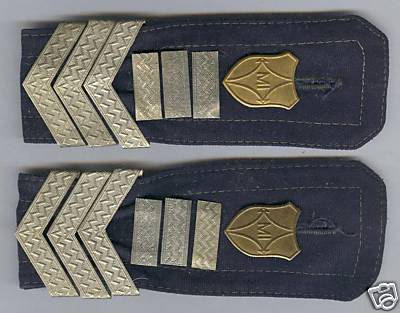
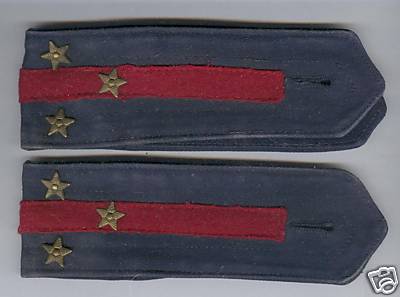
 0
0 -
Kevin,
Apparently, I skipped over one of your points regarding the shoulderboards. Insofar as I can determine, the Militia during the RPR period did not use brocade (gilt) on the shoulderboards (epaulets). They did follow the basic Soviet system but, whereas the branch colour is the background upon which the brocade is applied in the Soviet system- and shows through as "stripes" along the length of the epaulet (one for company grade, two for field grade), the RSR Militia actually applied the stripe itself to the epaulet. So, in the Romanian system of the time, a locotenant-major would have a blue epaulet, with an applied thin dark red stripe, and three small metal stars attached. I've actually seen a pair of these. Did the RPR Militia go to two thin stripes for field grade? I haven't seen these, but it would make sense. Now, the broad dark red "covering" on the uniform pictured- if logic is applied based on the other grades, this could be a general's set of epaulets. The stars could have been removed to avoid staining during long storage. OR, the whole thing could be fake.
0 -
Kevin,
With regards to the pin image you sent, I bid on one just like it and got beat out. I believe it's for a similar competition hosted by the Army. A great looking badge!
With respect to the ribbon bar (and I have 3 pictured in another thread in this section); it seems to me that the Romanian's tended to group ribbons according to "class" first, and then where the ribbon ranked on a chart. In other words (and using the example I posted), a 1st and 2nd Class Military Merit Order is pictured before a 3rd Class Tudor and a 3rd Class Distinguished Services in Defense of the Social Order and the Country BUT, because these are higher level awards, the 3rd Class Military Merit follows and then comes the 4th Class Star of Romania and etc.. This seems to be the case in most Romanian bars I've seen, though there have been exceptions that I just can not figure out. I hope I've explained this in a way that makes sense.
By the way, if you ever want to part with the bar that's 5th from the top, please let me know.
0 -
As others have said, this could be a restrike or, at best, unused old stock. It is, as listed, brass (bronze). The ad states, "only 50 manufactured"- I would say, rather, only 50 awarded. You just don't manufacture only 50 pieces once the dies are set-up- NOT cost effective.
$850 based on the above and what others have said just seems way out of line. I have seen this award (keeping in mind the caveats mentioned) for under $100.
0 -
And the back of the badge "For Cultural Work".
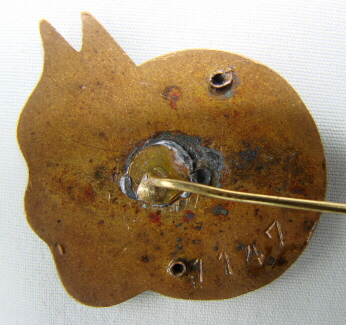 0
0 -
Picked up a couple Ministry of Internal Affairs badges... the badge on the right, an un-numbered pin back, is for an amateur artistic competition (probably music) and, based on the overall look of the badge, I would say from the RSR period. The badge on the left is for Culural Work and is of the stick-pin type. It looks to be 3-piece construction (the torch, the circular band bearing the type, and the base), and is numbered on the back- 1147. I believe it is of the RPR period. Both bear the "MAI" legend.
 0
0 -
Now to the ribbon bar, which is impressive. I won't bother to name all the awards as we all know most (if not all) of them already. The one foreign award is at the last place- the "30 Years of the Bulgarian Peoples' Army" commemorative medal. The awards I'm concerned with are the Orders of Military Merit (in places 1,2 and 5), the Medals of Military Merit ( in places 11 and 12), the Order for Distinguished Services in Defense of the Social Order and the Country - 3rd Class (in place 4) and the Defense of the Country medal (in place 13). From these ribbons, would it be correct to deduct that this individual was:
- very possibly a Colonel or General (over 25 years of service showing), and may have been in the regular Army (unless Military Merit orders and medals were given to the Ministry of Internal Affairs personnel).
- and a member of the Securitate (award #4).
Also, what organizations were awarded the Defense of the Country (De straj? Patriei) medal? Thanks for the help!
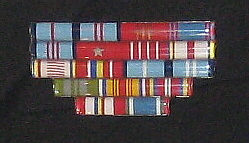 0
0 -
I don't own this item, but it was offered to me recently. As I don't collect uniforms because, frankly, I just don't have the room to do so, I turned it down. I did, however, make an offer for the ribbon bar- we'll see how that goes. Anyway, it was offered as a Militia uniform. Appears to be either charcoal gray or navy; dark red stripe on the pants and dark red piping on the cuffs; same colour collar tabs; dark red epaulets trimmed in blue. I'll get to the ribbons on the next post. I did have to lighten the image to show detail.
 0
0



My Shoulderboard Collection
in Russia: Soviet: Other Militaria
Posted
Doc,
The boards in post #14 appear to be early East German- boards for a 1952-56 Kasernierte Volkspolizei (KVP) Luft "Gefreiter" or, in English, a Barracked Peoples' Air Police Private First Class.